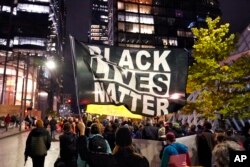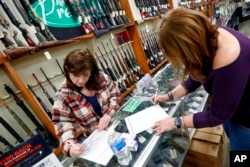Why Homicide Rates in US Spiked 30% During COVID Pandemic
[ad_1]
The number of homicides in the United States spiked almost 30% during the first year of the COVID-19 pandemic, a phenomenon seen in both cities and rural areas, and in Republican and Democratic-leaning states.
The proliferation of guns, pandemic stress and diminished public trust in the police all contributed to the increase in homicides nationwide, according to Justin Nix, an associate professor of criminology and criminal justice at the University of Nebraska Omaha.
“We have evidence that gun carrying in public spaces was up. … We know that the pandemic, with all of its strains and the uncertainties that it produced, the economic anxiety produced, likely played a role,” says Nix. “And then, lastly, the murder of George Floyd and the protests that happened after that sparked a police legitimacy crisis.”
On May 25, 2020, George Floyd, a 46-year-old Black man, was murdered by a white police officer in Minnesota, igniting nationwide protests against police brutality.
Previous research shows that officers reduce their efforts and crime increases in the aftermath of police killings that draw significant public attention.
“Police do slow down partly out of fear of being the next officer to get dragged on social media or in the news,” Nix says. “It’s a fear among officers that, ‘Even if I use force lawfully, even if I stopped this person, and it escalates into a use-of-force incident, even if my behaviors were perfectly legally reasonable, I still might find myself being the next star of a viral video.’”
Additionally, members of the public might be less likely to call police to report a crime, fearing their actions could do more harm than good.
“[They think] ‘If I call the police and they show up and they end up abusing this person or using excessive force on this person, I don’t want to contribute to what I see as a problem, so it’s safer for me to just not call 911,’” Nix says. “If people don’t report being victimized or report seeing other people victimized by criminal activity, then a lot of that will go unnoticed by the police.”
Clinical psychologist Dr. Maria Espinola, who has worked in jails and juvenile centers and is familiar with people who have violent tendencies, says certain people can grow more aggressive when they’re under stress.
“People who witnessed violence at home or in their communities when they were growing up, and maybe have a genetic tendency to aggression, can develop violent behaviors as a way to cope with stressful situations,” says Espinola, who is also an assistant professor in the Department of Psychiatry and Behavioral Neuroscience at the University of Cincinnati College of Medicine. “And then, when faced with a pandemic, you can see how many of them, in times of desperation, have turned to being aggressive towards others.”
FBI background checks suggest that gun sales are way up since the pandemic began in early 2020.
The bureau conducted the most ever firearm background checks — 1,218,002 — during a single week in March 2021, the highest number since the federal government began tracking gun sales in 1998. In fact, the nine highest weeks ever for gun background checks all occurred in 2020 and 2021, during the pandemic.
Solutions to gun violence aren’t easy to come by in a nation polarized by the debate over whether to limit firearm sales. However, 19 states have passed Extreme Risk Protection Orders (ERPO), which allow police or family members to petition a court to temporarily remove firearms from a person in crisis who poses a risk of harm to themselves or others. As long as the ERPO is in place, the person is also banned from buying firearms.
“I don’t think anyone would argue that one of the most polarizing topics in this country is gun violence prevention policies,” says Shannon Frattaroli, director of the Johns Hopkins Center for Injury Research and Policy. “We have seen almost half of states adopt this new kind of policy that allows for temporary prohibitions on purchasing and possession of guns, which is quite extraordinary, and demonstrates, in my mind, that there is a place where we can come together and agree on reasonable policies for gun violence prevention.”
While there have been calls from some quarters to abolish or defund the police, the vast majority of Americans oppose getting rid of police departments. However, about half do support reducing police department budgets and shifting those funds to social programs.
“Policing is necessary in a country awash with guns, where violence is common,” says Nix. “Policing is necessary and needs to be invested in. We need well-trained officers to have the tools and resources they need. We don’t want fatigued, stretched-thin officers who are sleep-deprived out exercising the authority that they have. We need to invest in police officers, but we also need to invest in community organizations that respond to violence as well.”
[ad_2]
Source link

